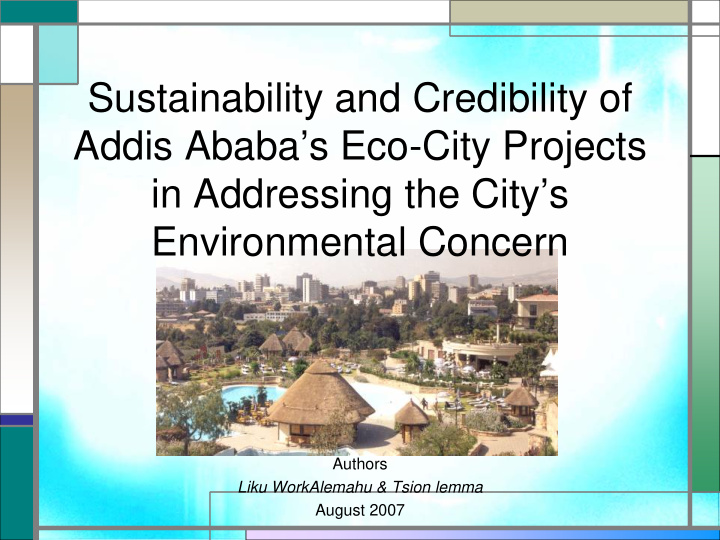



Sustainability and Credibility of Addis Ababa’s Eco-City Projects in Addressing the City’s Environmental Concern Authors Liku WorkAlemahu & Tsion lemma August 2007
Content of presentation • Introduction • Background • Introducing the Eco-City concept in Addis Ababa • Case study • Major challenges and Achievements • Concluding Remarks
Introduction • “human beings are the center of concern and an integral part of the development process for environmental protection and sustainable development” Rio’s declaration 1992 • “Improving and enhancing the health and quality of life of Ethiopians and promote sustainable social and economic development …” EPA 1997 • On the bases of International and national Agenda, Eco- city projects are launched in Addis Ababa in 2002
Background � 71.2% hh do not have adequate sanitation (UN-Habitat 2004) � Only 9% of households are connected with sewer line (UN-Habitat 2006) � 33.6% of hh share toilet facility with six or more families (UN-Habitat 2004) � Only 52.8% solid waste is collected by government, and a very small proportion by private the rest is thrown to the streets and rivers (UN- Habitat 2004)
Background • Planning and environmental development endeavors � Currently poverty reduction and slum upgrading programs are being undertaken based on National and Urban policies � Development actors are undertaking the interventions particularly upgrading, however, the interventions are integrated neither spatially nor institutionally lacking sustainability � On the other hand, Agenda 21 puts sustainable development as a way to reverse poverty
Introducing the Eco-City concept in Addis Ababa • Hence, the city government took a different approach for upgrading and adopted the Eco-City concept for its holistic approach and sustainability focusing on environment • Through adopting the concept, it was planned to incorporate ideas of � Comprehensive urban development system (Coordinated intervention) through community participation � Sustainable Development through implementing environmental measures
Eco-City Projects in Addis Ababa • Specific Objectives � Sanitation in terms of sewerage disposal, solid waste management � Accessibility in terms of mobility and infrastructure provision � Open spaces and green areas � Social service (health and education facilities) � Economic activities • Project Components � Relevant to low income groups � Take account of the existing situation � Replicable � Sustainable
The programme was initiated at city level � Steering & technique committees were organized and leading the project � Kebeles that are in need of immediate intervention and believed to be exemplary to adjacent kebeles were selected for the projects � 1 st phase 10 model kebeles and 2 nd phase additional 50 kebeles were selected and studied for eco- city projects
Status of the projects • General project level implementation � Widening of roads; market area and open space development; provision of communal toilets and street lighting; � Detail design and implementation of biogas and composting solid waste � Employment opportunities � Clearing and redevelopment of cemeteries
Gulele Sub-city Kebele 18 Gulele Sub-city kebele 18 Eco-City project • Land degradation and sanitation were the main problems identified • Waste damping places are rivers, open spaces and streets • High density of population compared with toilet facilities (only 26 communal and 457 private toilets for more than 35,000 people)
Gulele Sub-city Kebele 18 • Integrated public toilet, biogas and composting unit Currently the unit is functioning as a model but � Women and Youths are organized for solid waste collection � A number of families are beneficiaries of the public toilet � The biogas is being used as a model for lighting and cooking
Gulele Sub-city Kebele 18 • Eco-tourism � Located on the northern part of the city where there is high topography, natural forest development and a number of historical churches Taking the potentials of the area � Design of footpath to the historical site with the scenery down to the city � Design of shopping and display areas for the communities’ products (pottery and traditional clothes) along the trail to the historical sites
Achievements � Introduced wider neighborhood development approach creating sustainable development directions � The inclusion of environmental issues in the city development plan � It was possible to exchange ideas, practices and knowledge among different actors
Challenges � Lack of common understanding of the concept � Lack of integration between the eco-city projects and other projects � Organizational problems - no proper accountability � Launching of many projects at the same time � Poor managing and financing mechanisms
Concluding Remarks � Create awareness and reach to common ground and develop shared understanding on eco-city concept � Develop long & medium term eco-city development programs and design short & successive and interlinked short term projects in order to ensure the continuity of activities � Allocate the mandate and accountability of leading and coordination of eco-city projects to an appropriate body � Establish or enhance the existing kebele development committees to be able to incorporate needs of local community � Devise and search different financial sources or financing mechanisms in addition to regular budgeting of the projects � It is fundamental to incorporate sustainable environmental measures as a local policy; expand the scope and inculcate the concept into citywide development plan and various sector development programs of the city
Recommend
More recommend